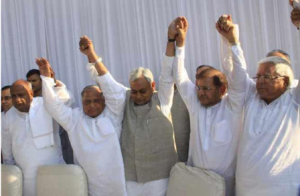General Election 2019: Would there be a turnaround for Janata Parivar?
The INC or the BJP need not be a national party to form the government, but #JanataParivar shall be a mighty alternative.

Repeated setbacks do not deter one from experiments, especially politicians and their coalitions or alliances. In Indian politics, Janata Party was an exceptional experiment done by the Gandhian Socialist Jayaprakash Narayan during the Emergency in 1977. Such that ‘Janata experiment’ has become a prominent term whenever there is an upsurge for political change.
This time too, it is not excluded and seems to be a possibility as #Magathbandhan contains as many as Janata avatars under the combination.
Main contenders of the nomenclature are Rashtriya Janata Dal (RJD) of Lalu Prasad Yadav, Janata Dal (Secular) under Deve Gowda, Samajwadi Party (SP) of Mulayam Singh, Rashtriya Lok Dal (RLD) of Ajith Singh, Sharath Yadav’s small entity and Indian National Lok Dal of Omprakash Chauthala sans Biju Janata Dal under Naveen Patnaik. The only missing oldie is Janata Dal (United) under Nitish Kumar.
Among these main players, BJD and Janata Dal (S) are in power in their respective states while SP and RJD are the primary opposition parties in two largest Indian states of Uttar Pradesh and Bihar respectively (in terms of constituencies).
“Adding Lok Sabha seats to all the relevant states would give a total of 179 which certainly is a headache for both the Indian National Congress (INC) and the Bharatiya Janta Party (BJP).”
Moreover, they have pocket burroughs in states like Rajasthan, Gujarat and Maharashtra that influence the voters who search for an alternative to two competing national parties.
Taking into account the number of seats in the above three states that comes under their ‘expected’ influence would be 278 in aggregate which would be short by more than 2/3rd majority in the Lok Sabha. Therefore, their influence shall not to be neglected.
| Party | State(s) | Total seats | Seats Projection | Seats
(2014) |
National Vote share (%) | Alliance |
| SP | U.P,
Maharashtra, Madhya Pradesh, Gujarat |
80 | 50 | 7 | 3.37 | BSP,RLD |
| RJD | Bihar and Jharkhand | 54 | 30 | 4 | 1.34 | INC+ |
| BJD | Odisha | 21 | 20 | 20 | 1.71 | None |
| JD(S) | Karnataka | 28 | 20 | 2 | 0.67 | INC+ |
| INLD | Haryana, Rajasthan and Gujarat | 61 | 30 | 2 | 0.51 | INC+ |
Aggressive Agenda
Mere unification of all the splinter groups/parties would not give credibility. Rather the agenda should be a comprehensive one. The umbrella entity should contest the poll with a common symbol. Their maiden symbol of farmer carrying plough was a great hit and suitable to appeal to the farmers who constitute majority of the rural segments and are under severe distress with crop failures and suicides.
Also read: Would Index of Opposition Unity work against NDA?
The new entity should also bring a Common Minimum Program and should pledge the voters that their regime, if voted to power, would last long till the final day of the tenure.
“Leadership to the new entity shall be decided before the poll rather than post poll. This will give impetus and credibility for the voters.”
Leaders such as Naveen Patnaik, Sharad Yadav and Akilesh Yadav and even Deve Gowda (may try a second chance!) are cherishing PM aspiration. However, they lack very precise or balanced political equations.
Factors may add to victory
There are several factors that may push the new entity towards success. One of the prime reasons is that they combine traditional outlook with a pro-farmer approach and appeal to rural development.
Ideologically speaking, they play a major role between BJP and INC, a Left-Centre politics but of course, not reversing the reform process. With a right mix of package that will address the middle class of the country, certainly the combine would swim through. In reality, the combine would pose a bitter challenge to the BJP as it has a mass appeal.
Janata Party rule has been still regarded as a ‘golden’ period on several grounds. It was only their internal fighting that led to the collapse.
Hence, the new combine should take more care in keeping together the flock to rule without disruptions.
Alliance and post-poll coalition
The Janata Parivar shall have fortune in finding both pre-poll alliance and post-poll coalition partners. Already Mahagathbandhan has taken place. However, keeping the INC as an alliance partner in Western parts of India and in Karnataka would give strategic victory.
Also read: TMC is already on the back foot: West Bengal BJP Chief Dilip Ghosh
However what remains is the decision of SP and BSP to keep the INC outside the alliance as an irrelevant party in UP. In the post-poll coalition, they can bring in TMC, AAP, TDP, NCP, TRS and even AIADMK (in case DMK fails to gain in numbers) to find enough strength to form the government. Already BSP and the Left are within the alliance.
“Surprisingly JD (U) may also opt to join the government if the BJP is not able to retain the reign.”
Hence, finding 300+ would not be a tough job. They could keep away the INC from the government to project itself as a true federal government in the making. In other words, the INC or the BJP need not be a national party to form the government, but Janata Parivar shall be a mighty alternative.
